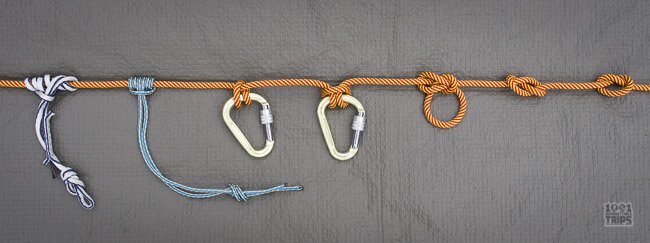
Spending a lot of time in the mountains? These are the knots you should master
When spending a lot of time in the high mountains you can’t avoid looking into knot techniques. As soon as the area gets rugged and steep or you want to cross a glacier you’ll have to secure yourself with rope and harness. And this is exactly where you need knots: to attach yourself to the rope, to secure your equipment, to abseil over steep rock faces or to rescue injured tour companions.
Even in less dramatic situations knots will come in very handy – basically every time you have to connect ropes or cords to an object. You can use knots to put up a clothesline or to help you prop up a tent. That’s why we would like to introduce you to some knots and encourage you to explore this topic further in the future.
Of course we can’t give you a list of possible knots here, but this isn’t really necessary since you’ll be well prepared for virtually any mountain tour with the below mentioned knots.
Two rules apply to all knots:
- they have to be properly fastened on all ends before putting weight on them
- when tying a knot at the end of a rope: the length of the overlaying rope (from the knot to the rope-end) must be at least ten times the thickness of the rope. So for example, at least 9 cm for a 9 mm rope.
Please be aware of the responsibility whenever you you start using knots for securing weights, roping up or abseiling of people. With careless use you endanger your life and the life of others, so it’s really important to be very confident in the use of any knots before you head off and apply your knowledge. Please don’t rely on this article only — this is only an overview, learning, understanding and practicing is up to you.
Overhand Knot (German: Sackstich)
The overhand knot is so simple that you usually use it unconsciously to tie your shoes or in other areas of daily life. If you give someone a rope or string and ask them to tie a knot they will go for the overhand knot 99% of the time.
In mountaineering this knot is used as a simple joining knot, but it has a bad consistency and is very dangerous to use for securing yourself or your partner. We use it to secure equipment to our belts or for everyday uses like putting up a tent, tying our sleeping bags or boots. Finally you can use an overhand knot to connect 2 ropes (offset water knot).


overhand knot with loop

overhand knot

offset water knot

overhand knot with loop
Figure-Eight Knot (German: Achterknoten)
The figure eight knot is named quite obviously: it resembles the number 8. This is a must-have skill. If tied correctly it’s one of the safest joining knots. The rope will break before this knot unties itself. So if you ask us which of the knots is most important it would have to be this one.


figure eight knot with loop

figure eight knot

figure eight knot with loop
Clove Hitch (German: Mastwurf)
The clove hitch is very useful to join an object to a rope. Combined with a carabiner this knot can be used to secure yourself from a safe stand. The usage of a clove hitch differs to the figure-eight knot in that this one can be used to easily adjust the length of the running end by feeding in rope from either direction and it will tighten by itself at the new position. When pulled tight the knot will stay fixed. Once learned this knot will be very useful as it’s very quickly set up and provides a very secure bond between carabiner and rope.


clove hitch

clove hitch without carabiner

clove hitch
HMS-Knot (German: Halbmastwurf)
The HMS-knot is the go-to instrument to secure your partner in the high mountains and may also be useful as a makeshift to abseil. The lack of needing to use extra devices like tube, ATC, figure-of-eight, etc. is the advantage of this particular knot. This fact will save you weight and room in your backpack. The downside is the extreme twisting and fast deterioration of the rope when using this knot.


HMS knot

HMS knot without carabiner

HMS knot
Anchor Bend (German: Ankerstich)
The anchor bend is a very easy knot that fastens itself under weight, and is very easy to untie. This knot is perfect for attaching materials or equipment to your belt. It’s also used to attach a via ferrata brake to the climbing belt. Warning: Only use this knot when both ends have equal strain on them. If the strain is stronger on one end the knot may loosen or even untie itself. It should also only be used on objects where it can’t revert (carabiner aren’t flattened and the knot can very easily revert).


anchor knot

anchor knot without carabiner

anchor knot
Prusik Knot (German: Prusikknoten)
A prusik knot is used to put a loop of cord around a rope that fastens under pressure and loosens when released. The prusik can also be used as slings along a rope. As soon as you put pressure on the knot it will ‘bite’ into the main robe and secure you in place. This is how you could use it to secure yourself to a rope i.e. to abseil. Furthermore it can be used to climb up a robe by taking turns with putting weight on two prusik knots. And you are able to use it to build a recovery aid like a hoist or to use it for the single-pulley technique.


prusik knot with two windings

prusik knot with three windings




